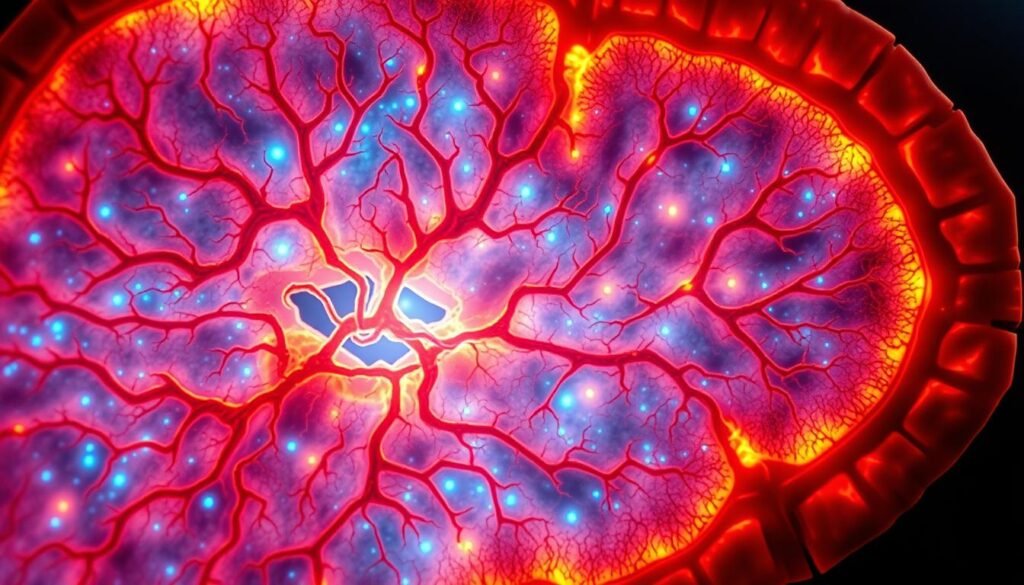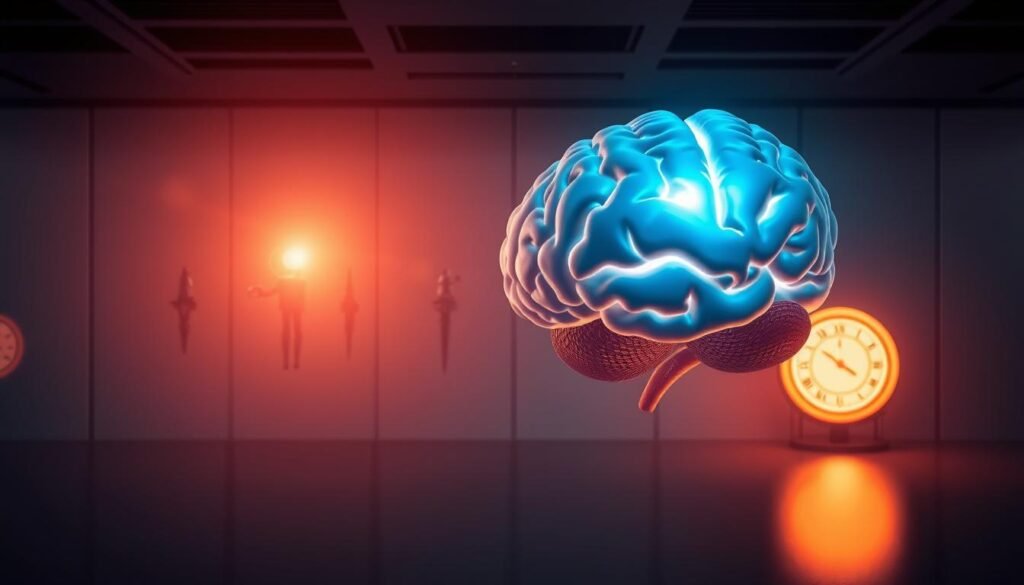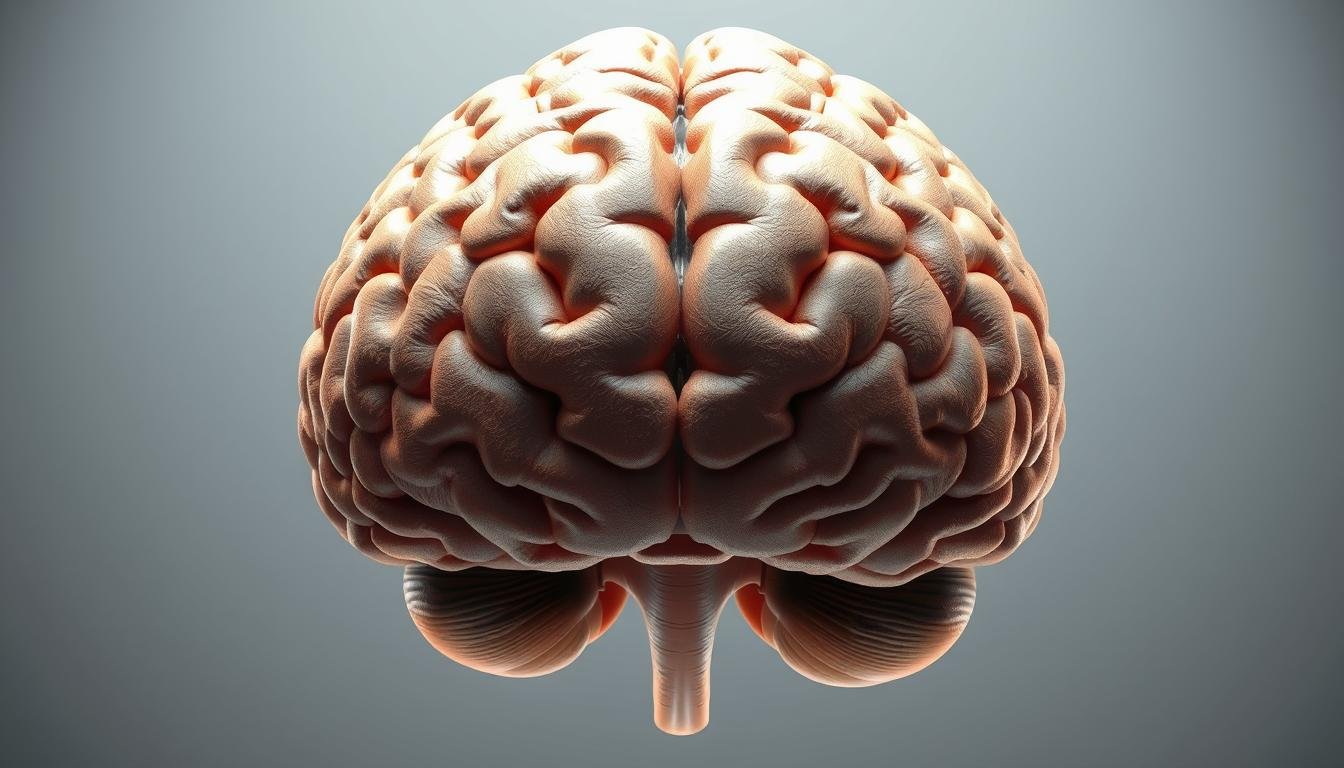A big 65 percent of Americans think we only use a little bit of our brain. This idea is all over in movies and books. But the 10% brain myth is not true. Scientists have found out that we really use most of our brain, proving the brain myth wrong.
The brain is very complex and always moving. It can’t be just a simple number. Different parts do different things, and most are working at some time. This article will look into where the 10% brain fallacy came from, how common it is, and how our brain really works.

10% Brain Myth Key Takeaways
- The 10% brain myth is a widespread misconception in American culture.
- Research in neuroscience has debunked this myth, showing that most parts of the brain are used.
- The human brain is a complex organ with various functions and areas of activity.
- Understanding brain function can help dispel common myths and misconceptions.
- The brain’s functionality is not limited to a specific percentage.
The Pervasive 10% Brain Myth in Popular Culture
The 10% brain story is big in movies and TV. It makes people think about using their brains more. It also makes creators think about how to show this in stories.
Entertainment Industry’s Role in Perpetuating the Myth
Movies and TV shows often say we only use 10% of our brains. This idea is used in many big movies. It grabs the attention of viewers all over the world.
The Film “Lucy” and Its Scientific Inaccuracies
The movie “Lucy” (2014) shows a woman using her brain fully. She gets super powers. But, this is not true. Brain scans show that different parts of the brain work at different times.
Even parts that seem not to be working are doing something important. This shows how “Lucy” got it wrong.
Other movies like “Limitless” also play with this idea. They say we can unlock more brain power. These stories are fun but spread a false idea about our brains. Looking at these movies helps us see how the 10% brain misconception is everywhere.
Related Reads:
- Flat Earth Middle Ages Myth: Why Medieval People Knew the Earth Was Round
- Thinking Clearly in a Messy World: Why Critical Thinking Still Matters
- Can AI Read Your Thoughts?
The Science: We Only Use 10% of Our Brain
“We only use 10% of our brains” is a myth that scientists have proven wrong. Yet, it’s still a popular idea. It’s based on wrong claims and misunderstandings, making people think wrongly about how our brains work.
Common Variations of the Claim
The idea that we only use a small part of our brain is shared in different ways. Two common versions talk about “dormant brain capacity” and “untapped potential.”
The “Dormant Brain Capacity” Argument
Some say a big part of our brain is just waiting to be used. But, science doesn’t back this up. Medical News Today says this idea is wrong.
Misrepresentations of “Untapped Potential”
Another version says we have lots of potential waiting to be found. While our brains are amazing, saying 90% is untapped is too much.
Why This Falsehood Is So Appealing
The idea of hidden talents is very tempting. It makes people want to find and use new brain abilities.
The Allure of Hidden Abilities
The thought of hidden talents is very exciting. As
“The human brain is the most complex and mysterious organ in the human body, and its potential is still not fully understood.”
This quote shows how fascinating the human brain is.
In short, the 10% brain myth is interesting but not true. By learning about brain science, we can see how amazing our brains really are.

Historical Origins of the 10% Brain Myth
The idea that we only use 10% of our brain comes from old science ideas. These ideas were wrong from the start.
Early Scientific Misinterpretations
In the 19th century, science didn’t know much about the brain. This lack of knowledge led to the belief that most of the brain was unused.
19th Century Neuroscience Limitations
In the 19th century, scientists had few tools to study the brain. They mostly looked at brains after people died. This led to wrong ideas about how the brain works.
William James and the “Untapped Potential” Quote
William James, an American thinker, is often linked to the 10% brain misconception. He talked about “untapped potential” in the brain.
How His Words Were Taken Out of Context
James’ words about “untapped potential” were misunderstood. He meant that people could do more, not that only 10% of the brain was used.
| Aspect | 19th Century Understanding | Current Understanding |
|---|---|---|
| Brain Function | Limited knowledge, relying on post-mortem exams | Advanced imaging techniques like fMRI and PET scans |
| Neuroscience Tools | Rudimentary experiments and observations | Sophisticated neuroimaging and diagnostic tools |
The 10% brain misbelief started with old science mistakes and a wrong quote from William James. Knowing where it came from helps us see why it’s so common.
How the 10% Brain Myth Gained Mainstream Acceptance
The 10% brain myth became popular because of wrong information and smart marketing. It stuck around because of many reasons.
Role of Media in Spreading Misinformation
The media helped spread the 10% brain legend. They made it seem true with exciting science stories.
Sensationalism in Science Reporting
Science news often picks the most interesting parts. This can make real facts seem wrong. It makes the 10% brain myth seem true to many people.
Commercial Exploitation of the Concept
Companies made money off the 10% brain fallacy too. They said their products could make your brain better.
Products Claiming to “Activate” Dormant Brain Areas
Many self-help books and apps said they could unlock your brain. They used fake science to make people want to buy them.
The Einstein Connection: Genius and Brain Usage Myths
Albert Einstein’s brain has always fascinated people. Many think we only use a small part of our brains. This idea links genius to brain use.
Claims About Einstein’s Brain Utilization
Some say Einstein’s brain was special because he used more of it. But, Scientific American says there’s no proof. They think geniuses might have something unique in their brains.
What Studies of Einstein’s Actual Brain Revealed
Einstein’s brain was kept and studied after he died. It showed some special things, like more glial cells in some spots. But, it didn’t show he used more of his brain than others.
| Feature | Einstein’s Brain | Average Brain |
|---|---|---|
| Glial Cells to Neurons Ratio | Higher in certain areas | Variable |
| Brain Structure | Unique features observed | Varied among individuals |
“The notion that Einstein’s brain was ‘special’ has been exaggerated… The available data do not support the notion that Einstein’s brain was unusually ‘active’ or that he used a larger percentage of it.”
This part clears up the misconception about Einstein’s brain. It shows what’s real behind the stories.
The Scientific Reality: Brain Structure and Function
Exploring the brain’s structure and function shows the truth. The human brain is very complex. Knowing its parts helps us understand how it works.
Basic Anatomy of the Human Brain
The brain has many parts, each with its own job. The cerebrum handles sensory info, movement, and thinking.
Major Regions and Their Purposes
The cerebrum has two sides: left and right. The left side deals with words, logic, and thinking. The right side is for spatial skills, recognizing faces, and music.
The cerebellum is at the brain’s back. It helps with movement and keeping balance. The brainstem links the cerebrum to the spinal cord. It controls breathing, heart rate, and blood pressure.
Specialized Regions and Their Functions
The brain also has special areas for specific tasks. Broca’s area helps with speaking, and Wernicke’s area with understanding words.
How Different Brain Areas Work Together
Brain areas work together for complex tasks. This teamwork is key for solving problems, remembering things, and even walking.
The brain’s detailed structure and function debunk the 10% brain myth. It’s a highly active organ. Different parts work together for human behavior and thinking.

Evidence Against the 10% Fallacy
New studies in neuroscience have proven the 10% brain myth wrong. This myth says 90% of our brain is unused. But, brain scans, evolutionary facts, and how much energy the brain uses all show it’s not true.
Brain Imaging Studies
Tools like fMRI and PET scans show our brain is always working. Scientific American says even simple tasks make our brain active.
What Modern Scans Actually Show
Scans show our brain has special areas for different jobs. Even when we’re not doing anything, parts of our brain are still working. For example, the default mode network is active when we’re not focused.
Evolutionary Arguments
From an evolutionary view, having unused brain parts is bad. Our brain uses a lot of energy, and natural selection favors efficiency.
Why Maintaining Unused Brain Tissue Would Be Disadvantageous
The brain uses 20% of our body’s energy but only makes up 2% of our mass. It’s expensive to keep unused brain parts, so evolution would likely get rid of them.
Energy Consumption of the Brain
The brain’s high energy use shows it’s always working. Even when we’re not doing hard tasks, our brain is still active.
The Brain’s Disproportionate Energy Usage
The brain uses a lot of energy for its size. This shows it’s very important and always busy. It’s not like it has big parts that don’t do anything.
In summary, brain scans, evolution, and energy use all prove the 10% brain myth wrong. Our brain is always active and has special areas for different jobs. It’s unlikely that any big part of it is unused.

Neuroimaging Technologies Revealing Full Brain Activity
Scientists now map brain activity with great detail thanks to new tools. These tools have shown that most of the brain works, even when we do simple things.
fMRI and PET Scan Findings
Functional Magnetic Resonance Imaging (fMRI) and Positron Emission Tomography (PET) scans help us understand the brain. Medical News Today says these tools show different parts of the brain work for different tasks. This proves not just a small section of the brain is used.
Visualizing Brain Activity During Various Tasks
Studies with fMRI and PET scans show the brain works hard for all tasks. For example, a simple task might use not just the motor cortex but other brain parts too.
EEG Studies of Brain Activity
Electroencephalography (EEG) studies also show the brain is fully active. EEG looks at the brain’s electrical signals, helping us see how it works in different situations.
Electrical Activity Throughout the Brain
EEG shows the brain’s electrical signals are everywhere, not just in some spots. This shows the brain works together as a whole, even when it’s not busy.
| Neuroimaging Technique | Primary Use | Key Findings |
|---|---|---|
| fMRI | Measures blood flow and oxygenation | Widespread brain activity during tasks |
| PET Scan | Measures metabolic activity | High metabolic activity across brain regions |
| EEG | Measures electrical activity | Electrical activity throughout the brain |
Dr. Marcus Raichle, a famous neuroscientist, said, “The brain is a highly active organ, even at rest.” This supports what many studies have found, showing the 10% myth is absolutely wrong.
The Cost of Maintaining Brain Tissue
Our brains need a lot of energy to work. This is why they are so expensive to keep going. The idea that we only use 10% of our brain is wrong.
Metabolic Demands of Neural Tissue
The brain uses a lot of energy. It uses about 20% of our body’s energy. But it only makes up about 2% of our body.
This is because our brain is always working. It needs to keep our body moving and thinking.
Why the Brain Requires So Much Energy
The brain needs a lot of energy for many reasons. Here are a few:
- Our brain is always active, even when we’re not moving.
- It has to keep the right balance of chemicals inside our cells.
- It makes and breaks down special chemicals that help us think.
Evolutionary Pressure Against “Unused” Brain Matter
Having extra brain tissue is not good for us. It costs a lot of energy. And it could even cause problems if it doesn’t work right.
Natural Selection and Efficient Brain Design
Nature wants us to have brains that work well but don’t waste energy. This is why our brain is so good at what it does. Different parts of our brain do different things.

Understanding how our brain works is very important. It shows us why the 10% brain myth is not true. Our brain is complex and works very efficiently.
Brain Plasticity and Adaptability
The brain can change and adapt throughout life. This is key for learning new things and getting better after brain injuries.
How the Brain Rewires After Injury
When the brain gets hurt, it can fix itself by making new connections. This is called neuroplasticity. Medical News Today says the brain can change itself after injury. It moves functions to other parts to make up for damaged areas.
Case Studies of Recovery After Brain Damage
Many people have shown their brains can heal from big damage. For example, people who had strokes can get back lost functions. Their brains make new paths to help.
- Reorganization of motor control
- Compensatory mechanisms in cognitive functions
- Role of rehabilitation in enhancing recovery
Learning and Neural Connections
When we learn something new, our brain makes new connections. This makes our brain stronger and can even make new paths.
How Practice Strengthens Neural Pathways
Doing something over and over makes our brain’s connections stronger. This is why we need to keep practicing to get better at something.
So, the brain’s ability to change and adapt is very important. It helps us recover from injuries and learn new things. Knowing about brain plasticity can help us improve our minds and get better from brain damage.
Harmful Effects of Believing the 10% Myth
Thinking the 10% brain myth can harm our view of the brain. It makes us not see how complex the brain is. It also makes us not understand the harm of brain damage.
Misunderstanding of Neurological Conditions
This widely held falsehood messes up how we see brain problems. For example, if we think 90% of the brain is unused, we might not see how serious brain injuries are. We might not get how bad neurological diseases are.
| Condition | Common Misconception | Reality |
|---|---|---|
| Brain Injury | Unused parts of the brain can compensate for damaged areas | Brain injuries can have significant and lasting impacts |
| Neurological Diseases | Diseases only affect “unused” parts of the brain | Diseases can affect any part of the brain, regardless of “use” |
Vulnerability to Pseudoscientific Claims
Scientific American says believing the 10% brain myth makes us easy targets for fake science. This includes pricey “brain training” programs and untested ways to improve thinking.
Expensive “Brain Training” Programs
Some companies say their brain training can use the “unused” 90% of the brain. They claim it boosts thinking skills. But, there’s no real science backing these claims.
Unproven Cognitive Enhancement Methods
Also, some products promise to boost thinking by “awakening” unused brain parts. These claims are often fake and can cost a lot of money.
Real Ways to Optimize Brain Function
The 10% brain myth is not true. There are real ways to make our brains better. We can use evidence-based methods and live healthy.
Evidence-Based Cognitive Enhancement
There are proven ways to make our brains smarter. Studies show certain activities can really help.
The Role of Physical Exercise
Exercise is great for our brains. It makes our memory better and helps our brain grow. Medical News Today says exercise is a key to brain health.
Mental Stimulation and Lifelong Learning
Doing brain puzzles and learning new things is good for our brains. It keeps our brain healthy and strong.
Lifestyle Factors Affecting Brain Health
Our lifestyle affects our brain health too. Things like sleep, food, and stress matter a lot.
Sleep, Nutrition, and Stress Management
Good sleep helps our brain remember things and get rid of bad stuff. Eating right and managing stress also helps our brain stay sharp.

What Does It All Mean?
The idea that we only use 10% of our brains is a big lie. It has shaped how we see our brains and how smart we think we can be. But studies and brain scans show we use a lot more of our brain than that.
Challenging this misconception helps us see how amazing our brains are. It shows us how much our brains do every day. This makes us value the ways we can make our brains better.
Instead of believing old myths and stories, we can choose to live smarter. We can pick habits that science says are good for our brains. This makes us think better and feel better too.
It’s important to share real facts about our brains. We should tell others the truth about how our brains work. This helps us all understand ourselves better.
FAQ
What is the 10% brain myth?
The 10% brain myth says we only use 10% of our brain. It claims the other 90% is unused.
Is it true that we only use 10% of our brain?
No, this is a myth. Studies show our brain works in different ways. Even the parts not working seem to do important jobs.
Where did the 10% brain myth come from?
The myth’s start is unclear. It might come from a wrong idea about psychologist William James’ work.
How has the 10% brain myth been perpetuated in popular culture?
It’s seen in movies, TV, and books. It’s used to explain special abilities. For example, “Lucy” shows a character using 100% of her brain.
What does neuroscience say about brain function?
Neuroscience says our brain is complex and connected. It has special areas for different tasks. Studies show simple tasks use many brain areas.
How does the brain use energy?
The brain uses a lot of energy, about 20% of our body’s energy. This energy helps brain cells work and supports neural activity.
Can we really “unlock” hidden brain potential?
No, there’s no proof for unlocking hidden brain power. Our brain can change, but not by tapping into hidden areas.
What are some evidence-based ways to optimize brain function?
To improve brain function, try regular exercise, enough sleep, and cognitive training. Eating well also helps brain health.
How does brain plasticity relate to the 10% brain myth?
Brain plasticity means our brain can change with new experiences. But, it doesn’t mean 90% of our brain is unused.
What are the consequences of believing in the 10% brain myth?
Believing this myth can lead to false hopes for brain improvement. It can also confuse people about brain health and abilities.
Sources:
Veerakone, R. (2024, March 4). Do we only use 10 percent of our brain? – MIT McGovern Institute. MIT McGovern Institute. https://mcgovern.mit.edu/2024/01/26/do-we-use-only-10-percent-of-our-brain/
Palmer, O. (2023, September 25). Debunking the myth: The science behind the 10% brain usage fallacy – Thescienceblog. Thescienceblog. https://www.thescienceblog.net/debunking-the-myth-the-science-behind-the-10-brain-usage-fallacy/
Lee, M. (2023, November 7). Misconceptions: the truth about brain usage: debunking the 10% myth — communicating psychological science. Communicating Psychological Science. https://www.communicatingpsychologicalscience.com/blog/misconceptions-the-truth-about-brain-usage-debunking-the-10-myth






